I recorded in 2023.
Need more basic information on infrared? Visit Cool Cosmos.
Want more information about low-mass star formation? This
article from American Scientist in 2001 has more information
as well as a great cartoon in figure 2.
Click on any image to be taken to the original image's web page for more information on that image.
Vast clouds of gas and dust are swirling throughout our Milky Way
galaxy. Many of these clouds are stellar nurseries, places where one
(in the case of small clouds) to tens of thousands of stars (in the case
of the largest and most massive clouds) are being born right now!
These clouds range in size from cores that are 100,000 times the size
of the Solar System and mass of several Suns (solar masses), to giant
clouds more than ten million times the size of our Solar System and many
thousands to tens of thousands of solar masses. A typical star-forming
cloud might create a very few massive stars (20 solar masses or more),
many stars like our Sun, and many more lower-mass stars and brown
dwarfs, which are objects of mass well smaller than that needed to
produce star fueled by nuclear fusion (0.08 solar masses). An umbrella
term for all of these newly- forming objects is young stellar objects
(YSOs).
The Spitzer Space Telescope has been incredibly powerful in
furthering our understanding of how YSOs form and evolve. There are
multi-band Spitzer images of about 300 square degrees of the Galactic
plane, with more than 100 million sources. There are maps of about 70
square degrees in nearby (within about 1500 light years) star-forming
regions, with about 8 million total sources. Conservatively, I estimate
that there are about 20,000 YSOs in this rich data set. We are still
learning from Spitzer's data, and we will learn from it for decades to
come.
Spitzer's data, alone and combined with data from other
telescopes, enable understanding of many things, including the factors
that control the efficiency of the star-formation process in different
clouds, what determines whether a high- or low-mass star forms in
different parts of stellar nurseries, and how the process of star
formation across all masses is related to the formation of planetary
systems and ultimately life-bearing planets analogous to our own Solar
System.
Astronomers have developed guidelines -- reasonable ideas --
regarding the basic processes of star formation for stars like our Sun.
This working framework derives both from numerical modeling and
observations of forming YSOs, not only with Spitzer, but with other
telescopes that are capable of probing the physical, chemical and
dynamical state of the gas and dust that ultimately collapses to form
stars. Similar processes are likely to operate in much more massive
stars (only faster) and brown dwarfs (only slower).
We believe that stars are born in rotating cores, comprised of
gas (100 parts) and dust (1 part), which begin to collapse when the
force of gravity (dependent on the mass and radius of the core) exceeds
the internal pressure (a measure of the internal motions of material
within the core -- motions that push back against the inward pull of
gravity). The collapsing, rotating core forms a central "stellar seed,"
surrounded by a geometrically thin disk. The rotating seed-disk system
is continually fed from the material in the rotating cloud. The orbiting
disk material plays a crucial role in two ways: first, in transporting
material from the cloud to the central seed, allowing the seed to
eventually (over several hundred thousand years) to reach a mass
comparable to that of the Sun; and second, in providing the material
from which planets can form. This results in planetary systems like our
own, where all the planets are in a plane, rotating in the same
direction -- this is a remnant signature of our own protoplanetary disk.
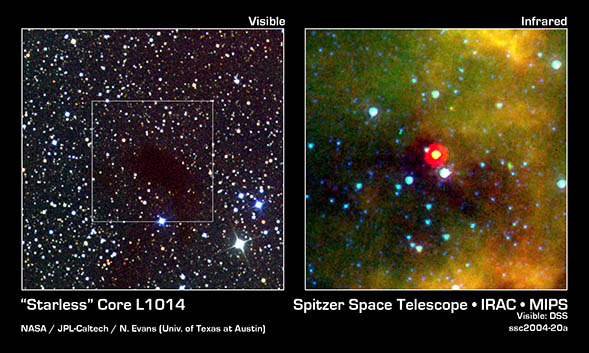
Comparison of visible (left) and Spitzer infrared
(right) image of the protostellar core L1014. The bright yellow object
at the center of the image is a forming star, detected via Spitzer's
ability to penetrate the optically opaque dust contained in the
protostellar core. The red ring surrounding the object is an artifact of
the reduced spatial resolution of the telescope at 24 microns.
The very young star+disk+cloud system is completely hidden in the
optical -- the dusty cocoon of matter obscures the central object in
the visible bands. These objects emit the majority of their light in the
infrared. Prior to Spitzer, we knew of only about 50 stars at this
stage of development. However, with Spitzer, we have now detected
several hundred of these protostellar cores, whose presence is inferred
from unique patterns of brightness vs. wavelength. At Spitzer's shortest
wavelength (3.6 microns), the light comes mainly from the forming star
at the heart of the core. At longer wavelengths, the light from the
object becomes stronger, a signature that it is not a background star.
Also, in the longer wavelengths (8 and 24 microns), you can see the glow
from interstellar dust surrounding the YSO, glowing green to red in the
Spitzer composite image. This dust consists mainly of a variety of
carbon-based organic molecules known collectively as polycyclic aromatic
hydrocarbons (PAHs). The red color traces a cooler dust component.
Owing to its tremendous sensitivity, Spitzer is able to probe
star-forming clouds more than 20 times further from Earth than had been
probed by previous ground- and space- based observations. As a result,
we now have a catalog of newly- formed stars spanning nearly the full
range of known stellar masses -- a crucial precursor to understanding
what kinds of natal protostellar cores give birth to what kinds of stars
and why. Follow-up observations with sensitive radio telescopes provide
measurements that allow us to assess the masses, internal motions and
rotation speeds of these cores -- critical factors to understanding the
kinds of conditions conducive to forming stars of different masses, and
to determining the characteristics of the disks that ultimately form
planetary systems.
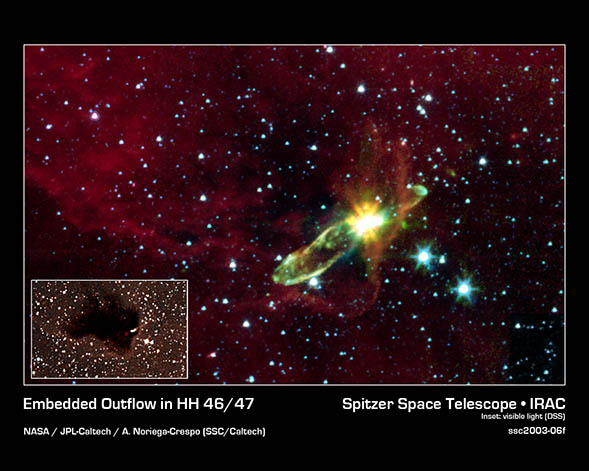
HH 46/47, a YSO ejecting a jet and creating a bipolar
outflow. The central protostar lies inside a "Bok globule," hidden from
view in the visible-light image (inset).
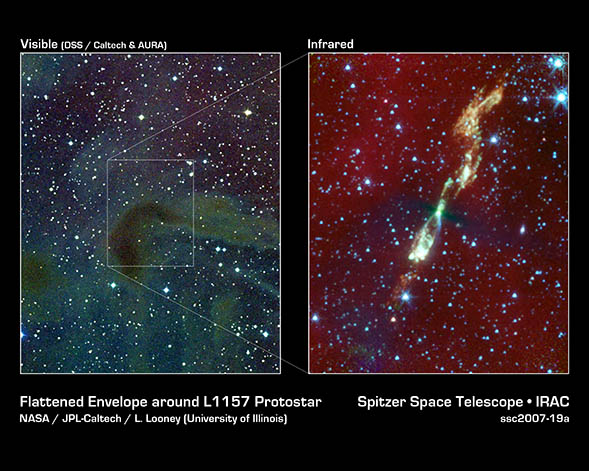
L1157, a YSO ejecting a jet; a nearly edge on disk can be seen here as well.
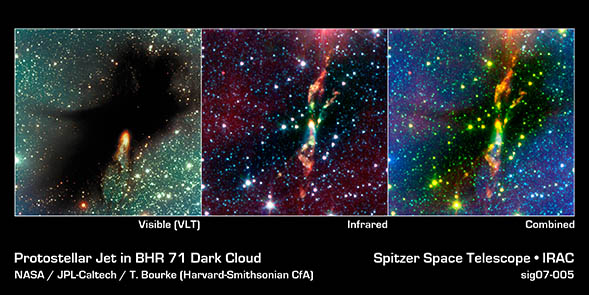
BHR 71, a dark cloud with two young stars inside. The cloud is actively being destroyed by the jets from these young stars.
The birth of a star is a violent event. Early in its evolutionary
history, while the YSO is still embedded and optically invisible, a
powerful, highly-collimated, jet- like outflow begins to emerge from the
protostellar core. Outflows are a signpost that material from the core
has formed a disk surrounding the embedded stellar seed, and that the
disk has begun to transport material to the surface of the cocoon. This
accretion process results in the launching of jets, or outflows. The
precise launching mechanism for jets is unknown, but is likely to be
related to rotation, magnetic fields, accretion, and the interaction
between the star and the disk. About 10% of the matter that is accreted
through the disk is ejected as an outflow or jet. The jets can reach
sizes of trillions of miles and velocities of hundreds of thousands
miles per hour. The launching of jets through the accretion process may
be nature's way of limiting or controlling the ultimate mass of the star
that forms -- the jets disrupt the cocoon and remove material that
would otherwise ultimately reach the forming star at the center of the
cloudlet. With Spitzer, the forming star and its jets of molecular gas
appear with clarity; three examples are given above. The 8-micron
channel is sensitive to emission from PAHs, which are excited by the
surrounding radiation field and become luminescent. The shock fronts
from jets of material plowing supersonically into the cold, dense gas
nearby are easily visible. In particularly active regions of star
formation, as seen in NGC 1333, 100s if not 1000s of jets are found,
each (pair) of which can be traced back to a parent YSO.
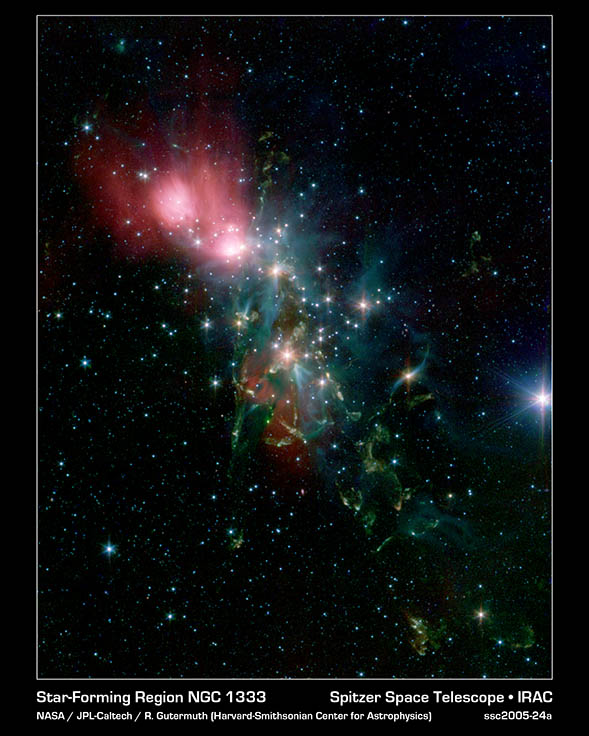
An abundance of jets (seen here as the green arcs) in NGC 1333.
During the assembly of the star-disk system, both the central
star and disk are obscured from observations using conventional optical
telescopes by the collective effects of micron-size dust grains in the
natal material surrounding the YSO. Ultimately, through the combined
effects of incorporation of core material onto the star and the
dissipative role of outflows/jets, the cocoon of material surrounding a
forming YSO is disrupted, ultimately rendering star-disk systems
visible. Superb examples of this phase of star formation are provided by
Hubble Space Telescope imaging of nearby star-forming regions such as
the Orion Nebula Cluster. Here, the background light from the Orion
Nebula (an ionized hydrogen region) allows the emerging star-disk
systems to be seen in silhouette, or glowing themselves in response to
ultraviolet photons in the region.
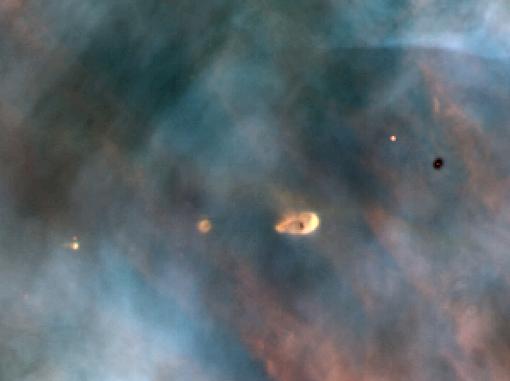
A Hubble Space Telecope view of a small portion of the Orion Nebula shows 5 young stars (the point-like objects).
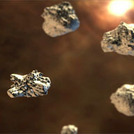
Click the image to view an artist's concept (movie) of a disk surrounding a young star, zooming in on icy olivine grains in the disk.
Some YSOs are close enough that with Hubble or ground-based
interferometers, we can resolve the disk without external illumination
as is found in Orion. Edge- on disks provide particularly dramatic views
of the disk, where a dark lane slices through the image of the YSO. The
initial distribution of dust within a disk mimics the shape of a
saucer: flat near the central star, and "flaring" upward at larger
distances. This characteristic shape reflects the combined effects of
gravity pulling material downward toward the midplane, and thermal
pressure of heated gas and dust pushing against the force of gravity.
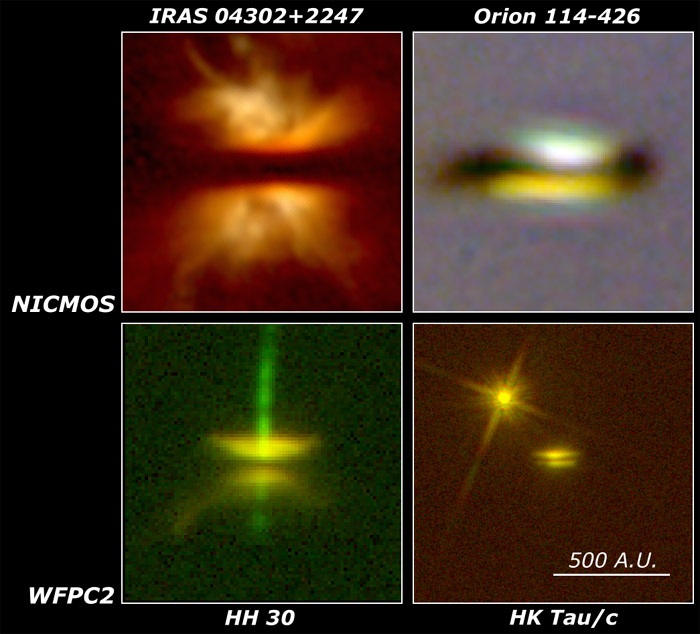
Images of nearby edge-on disks observed by the Hubble
Space Telescope. All images are shown to the same linear scale, with
each box being about 20 times the diameter of Neptune's orbit.
In more distant star-forming regions, or in regions which lack
the background illumination provided by the Orion Nebula, the presence
of emerging YSOs can be inferred from Spitzer observations of spectral
signatures specifically indicative of systems characterized by orbiting
dust, illuminated and heated by a central star. (See figure below.) The
brightness as a function of wavelength for a plain star (no dust around
it) results in most of the light being produced at shorter wavelengths.
In the case of a YSO with a disk of dust and gas around it, the disk is
heated by the star, and the warm dust and gas around the star produces
its own infrared light, which changes the shape of the spectrum we see
from the combined star+disk. The circumstellar material is cooler than
the surface of the star, so it emits most of its light at longer
infrared wavelengths -- there is an excess of infrared emission, which
cannot be coming from the star itself, betraying the presence of the
disk. The inner part of the disk can be swept away, perhaps by the
formation of a planet via agglomeration of the small dust grains
responsible for producing excess emission in the inner regions of the
disk. The dust closest to the star is also the hottest, so its absence
means that there is less emission from the disk from its inner regions.
The only dust producing infrared light is much further away from the
star, and much cooler, producing as a result emission only at long
wavelengths. This resulting "bump" or inflection in the spectrum
indicates a disk with a missing center, and may be the first clue that
planets have formed inside the disk.
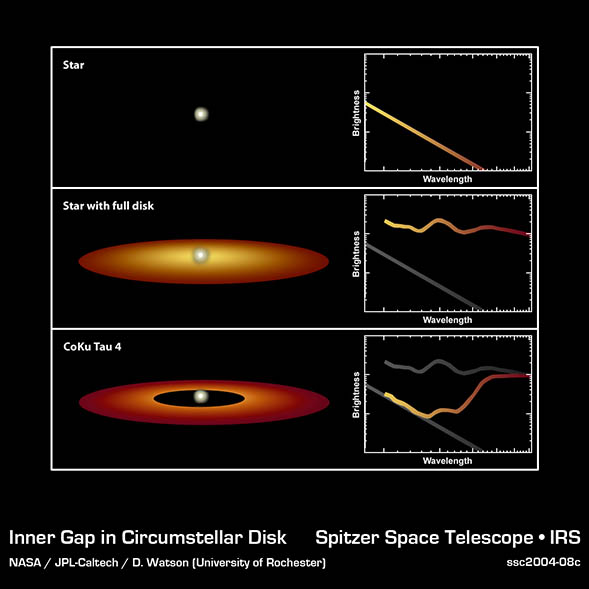
How we infer that a star has a protoplanetary disk
around it, when the disk is too small to image directly. The left column
indicates the physical situation, and the right column indicates the
patterns of brightness as a function of wavelength (longer wavelengths
on the right) that are observed.
Using these patterns of brightness, Spitzer observations,
combined with optical observations made from the ground, can provide a
census of the number of forming stars that in fact are surrounded by
disks. Studies of tens of star-forming regions, including the greater
Orion complex, reveal 1000s of likely YSOs, and find that more than 80%
and probably all stars less than about a million years old -- ranging in
mass from 20 solar masses or more, to objects of mass well smaller than
that needed to produce star fueled by nuclear fusion (0.08 solar
masses) -- are surrounded by disks.
By using Spitzer's power to carry out a virtually complete census
of star-disk system in star-forming clouds, it is possible to begin to
study under what conditions stars form in relative isolation or in dense
clusters, whether the formation of particular kinds of stars can
trigger the formation of new generations of stars, and ultimately, how
the stars that now populate the sea of stars in our Milky Way galaxies
came to be over time.

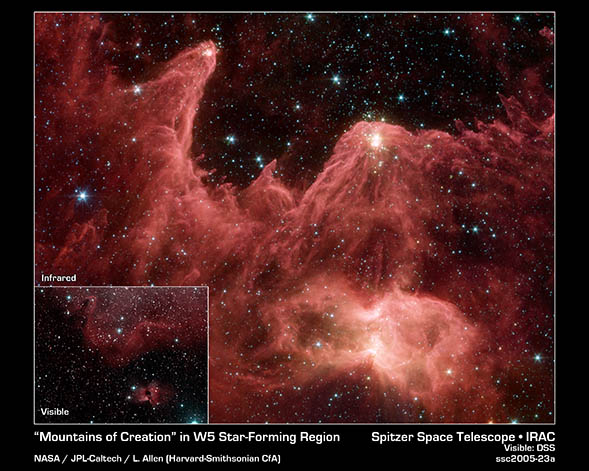
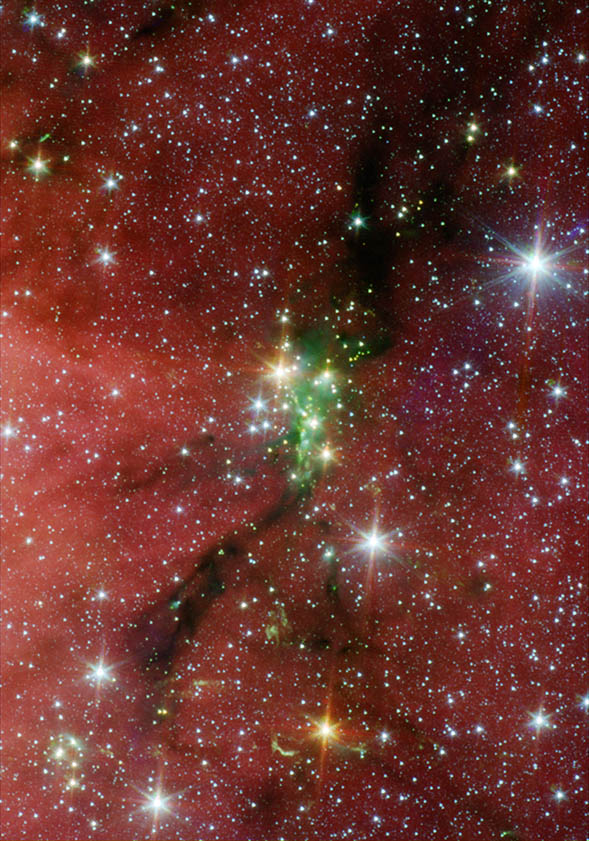
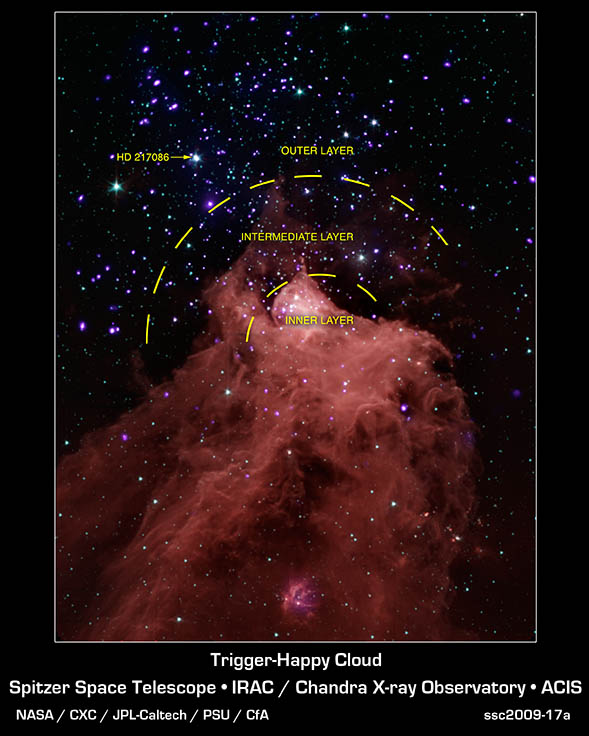
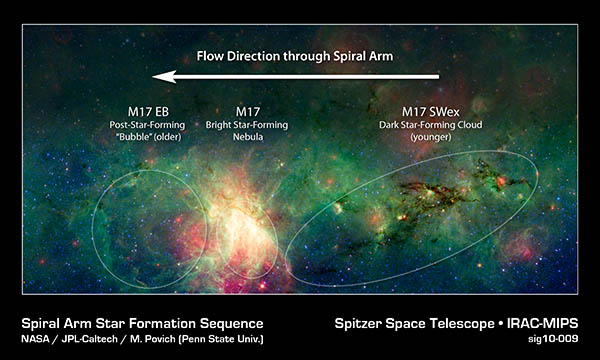
Several examples of embedded star formation, some triggered.
More than 25 years ago, astronomers noted that regions that form
stars with masses well in excess of 10 solar masses -- regions like the
Orion nebula -- not only formed signature ionized hydrogen regions (gas
fluorescing in response to the strong ultraviolet light emanating from
massive stars) but also seemed to be associated with other groups of
nearby, newly-formed stars. At the time, a few prescient researchers
suggested that the formation of a massive star and its associated nebula
of ionized gas could ultimately trigger the formation of another
generation of young stars.
Spitzer's ability to pick out newly-formed star-disk systems via
their signature colors has provided dramatic proof that triggered star
formation occurs, and indeed may play a major role in turning clouds of
gas and dust into stars. A newly-formed massive star creates an
associated ionized hydrogen region and a plethora of newly-formed stars
located at the rim defining the interface between the ionized region and
the remainder of the cloud. The propagation of the hot, ionized
material into the cold gas and dust in the surrounding star apparently
compresses gas and dust at the boundary, forcing clumps of material into
volumes small enough so that gravity can overcome internal pressure --
thus beginning the collapse of a YSO. The details of the triggering
mechanism, and how the mix of stellar masses formed in triggered regions
differs from the mix found in regions which form stars "spontaneously"
(e.g., by the passage of a spiral arm through the clouds of gas and
dust) is yet another mystery that promises to find ultimate solution by
combining Spitzer data and observations from other bands.
Spitzer's census of star-disk systems can provide significant
clues regarding the kinds of planetary systems that can form around
stars like the Sun (as well as stars of other masses), and ultimately
answer a key question: is a Solar System like ours a typical outcome of
the star formation process, or is it rare? Follow-up observations
suggest that at least half of the disks detected by Spitzer have mass
sufficient to form a planetary system similar to our own. More modest
systems -- perhaps lacking our gas giant planets -- could well form
around the remaining 50%. Hence, most, if not all stars form with disks
of mass sufficient to form a planetary system, and at least 1/2 can in
principle assemble planetary systems similar to our own (as judged by
total available disk mass).
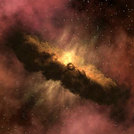
Click the image to view an artist's concept (movie) of a disk surrounding a young star, zooming in on a protoplanet sweeping up a gap in the inner disk.
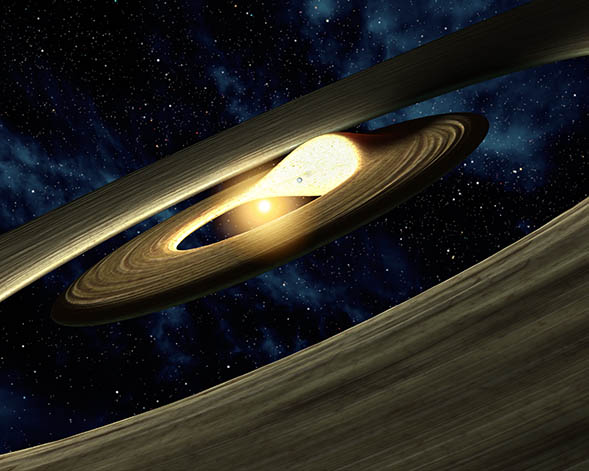
Artist's conception of asymmetric "blob" of matter surrounding a protoplanet forming in a circumstellar disk.
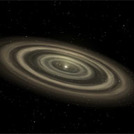
Click the image to view an artist's concept (movie) of a disk surrounding a young star,
with many planets forming at once, creating many gaps. The physics here
is essentially identical to that found in Saturn's ring system, only
there the central mass (Saturn) is much smaller than a protostar, and
the objects in the disk (moons) are smaller than the protoplanets.
Following the formation of a star-disk system isolated from its
parent protostellar core, the micron-size dust embedded within the
largely gaseous disk begins to settle toward the midplane -- much as
dust raised by a windstorm eventually settles earthward, clearing the
air. Dust settling to the midplane results in an increase in the density
of solid material, a fact that leads to very frequent collisions among
the micron-size grains. Such collisions can quickly lead to merging or
fusing of the micron-size grains into larger entities. Simulations --
both in the computer and in the laboratory -- suggest that once
micron-size grains settle to the disk midplane, they can quickly form
larger grains, and soon thereafter, kilometer-size bodies (within
several hundred thousand years).

Click the image to view an artist's concept (movie) of two protoplanets colliding in a
disk surrounding a young star, creating a second generation of dust,
which is then smeared out (due to gravitational interactions) into an
arc or ring of dust.
Collisions among these larger bodies (called planetesimals) can
in turn produce even larger entities -- planetary cores of lunar, Earth,
and even 10s of Earth-mass size. These collisions are accompanied by a
"second generation" of dust that within a few orbits gets smeared out
into arcs or rings. In the inner regions of disks, near the orbit of the
Earth, buildup from grains to earth-size bodies can take place on
timescales of several million years. Terrestrial planets (Mercury,
Venus, Earth and Mars) are likely to form following this general
picture. The cores of the gas giants probably form similarly, but are
able to accumulate more of the lighter elements in a runaway process.
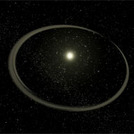
Click the image to view an artist's concept (movie) of a protoplanetary system with collisions causing temporary arcs and rings of dust.
Whether or not Jupiters in other systems are able to form, and
remain orbiting their parent suns near the place they formed, depends
critically on when they form and how much remaining disk material lies
outside their orbits. Extra-solar Jupiters that form early, and in
systems with massive outer disks, will, via gravitational interaction
with outer disk material, be forced to migrate inward -- perhaps
explaining the presence of the large number of extrasolar Jovian-mass
planets found orbiting much closer to their parent stars than our own
Jupiter. Migration of such Jupiters from their place of origin may have
catastrophic effects on already- born terrestrial planets; the powerful
gravitational field of the inward moving Jupiter could well eject these
planets from their planetary systems. It may be that our Jupiter formed
at just the right time -- when there was enough material left in the
disk to build a planet of its mass, and late enough, so that material in
the outer disk did not force it to migrate inward.
Some collisions that occur late in the planetary formation
process can destroy worlds. In one recent Spitzer result, there were
spectral signatures of molten rock, suggesting that we are seeing
remants of a very recent very large collision.
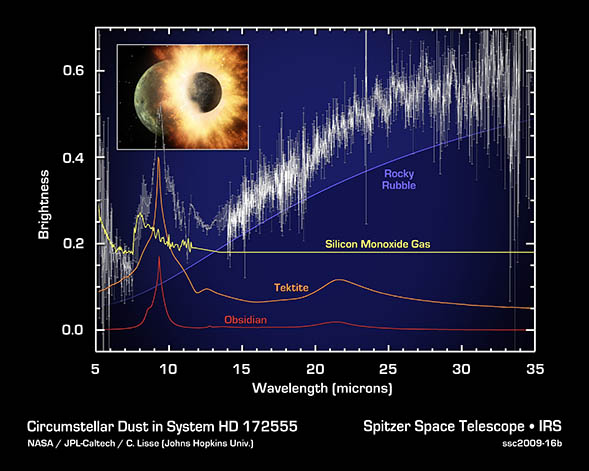
The spectrum above shows the
thumbprint of obsidian, a difficult signature to reproduce without
molten rock.
In the outermost regions of the disk, the material thins out, and
even the dust-rich disk midplane is only able to form bodies of much
lower mass. These outer disk regions may be the birthplaces of objects
such as Pluto, and much smaller icy comets which populate the region
exterior to Neptune's orbit in our own Solar System: the Kuiper Belt.
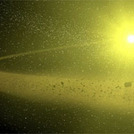
Click the image to view an artist's concept (movie) of a distant planetary system
similar to ours. In the movie, we move out past this system's Asteroid
Belt and wind up in its Kuiper Belt.
Eventually, the gas and dust in the disk is either assembled into
planets or smaller bodies spanning a range of masses and orbital
distances, accumulated by the central star or gravitationally ejected
from the forming system via gravitational interactions with the more
massive orbiting bodies. The basic elements of other planetary systems
are likely in place by no more than 10-30 million years after the
initial core began its collapse.
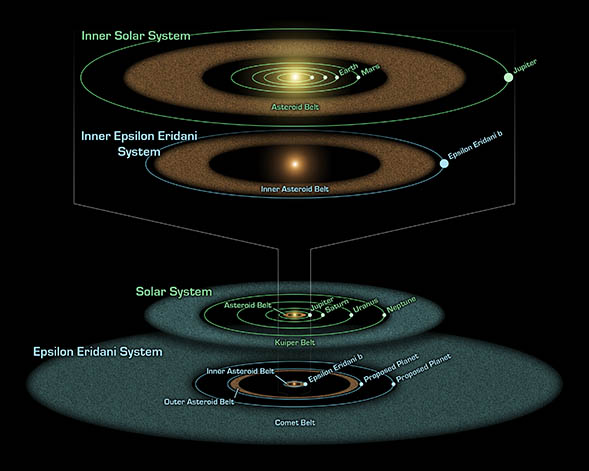
Schematic comparing the dust/planetary system around the
nearby star Epsilon Eridani (in science fiction, the Vulcan homeworld
system) as compared to ours. Note similar locations of dusty belts and
planets.
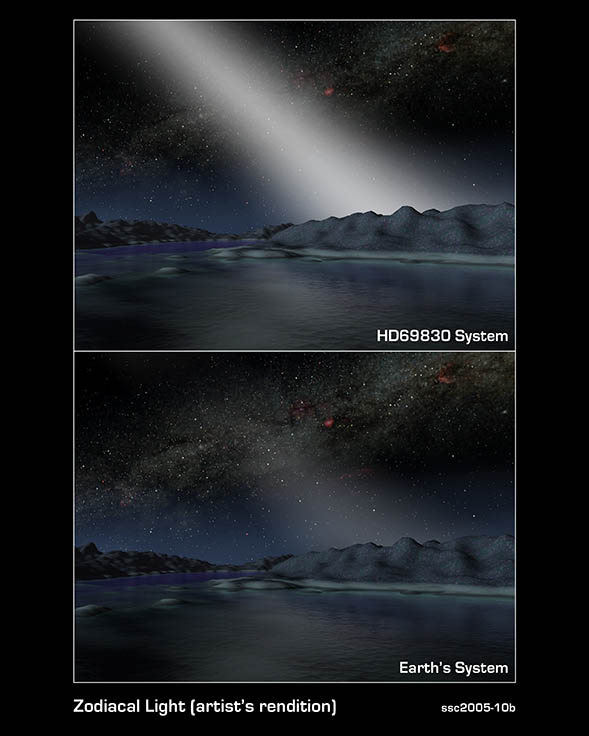
Artist's conception of the light that comes from remnant
disks (called the "zodiacal light") from a very dusty system, HD 69830,
and, for comparison, from our own Solar System.
Evolution of the planetary system however continues, even
billions of years after formation, as gravitational interaction among
planets, comets and asteroids results in readjustments of orbits, and
ongoing cosmic collisions, which produce as a by-product micron-size
dust grains. Our own Zodiacal light, visible with the naked eye at dawn
and dusk (from a very dark location on a moonless night), provides vivid
evidence of these ongoing processes in the light scattered Earthward by
small, collision-produced dust grains. The Zodiacal light in our system
is rather weak compared to some of the other much dustier systems
astronomers have found (such as HD 69830). Evidence of collisions is
found throughout the Solar System, most vividly etched in craters on the
face of the Moon and other bodies lacking atmospheres. The
collision-produced grains are heated to temperatures ranging from 1000
degrees near the Sun to 10s of degrees near the outer reaches of our
Solar System. These heated grains (here and in other planetary systems)
can be detected by Spitzer, and provide a powerful probe of ongoing
collisions among smaller bodies even in relatively mature planetary
systems.
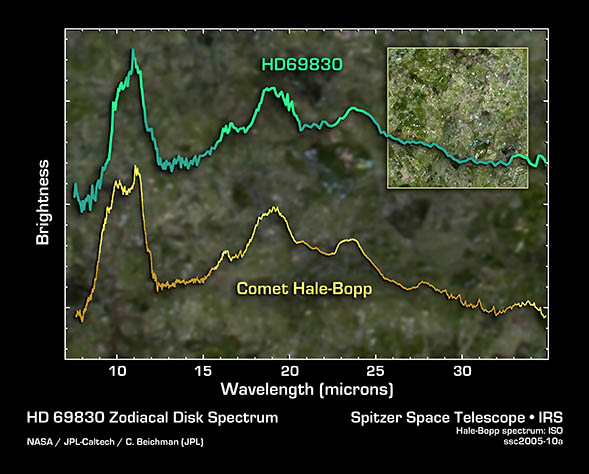
Spectra (middle four lines) from Spitzer of dusty disks
around four brown dwarfs, in comparison to interstellar dust (top) and
Comet Hale-Bopp (bottom). The light green vertical bands highlight the
spectral fingerprints of crystals made up primarily of a green silicate
mineral found on Earth called olivine. The broadening of these spectral
features or bumps indicates silicate grains of increasing size.
Stars much less massive than our Sun are likely to form and
evolve the same way, only on longer time scales. Spitzer results show
grain settling in disks around brown dwarfs, just as in more massive
stars.
At the other end of the scale, stars much more massive than our
Sun have enough core temperature and pressure to ignite hydrogen very
early in the process described above, quickly blowing away their natal
material. Not only will those stars start burning H early on, but
eventually they are likely to explode as supernovae and trigger star
formation in the surrounding molecular cloud, starting the cycle again.
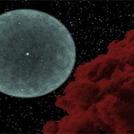
Click the image to view an artist's concept (movie) showing this process of triggered star
formation. A massive, dying star explodes or "goes supernova." The shock
wave from this explosion passes through clouds of gas and dust. A new
wave of stars is born within the cloud, induced by the shock from the
supernova blast. The whole progression, from the death of one star to
the birth of others, takes millions of years to complete.
Originally written by L. M. Rebull, circa 2009
























